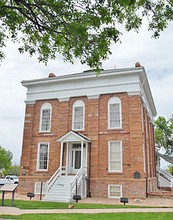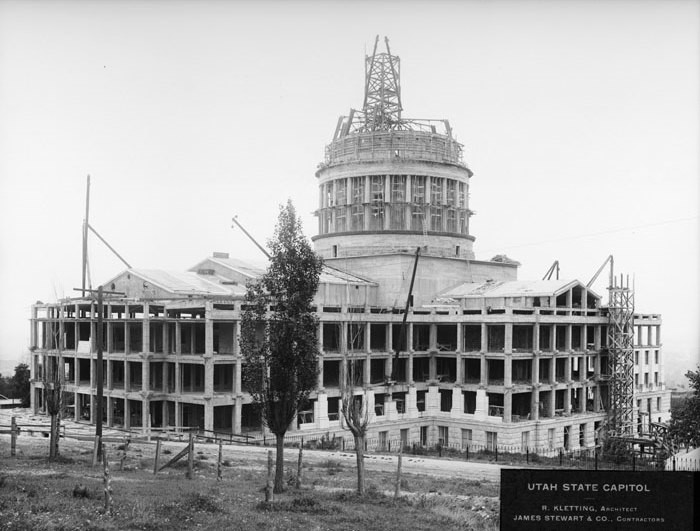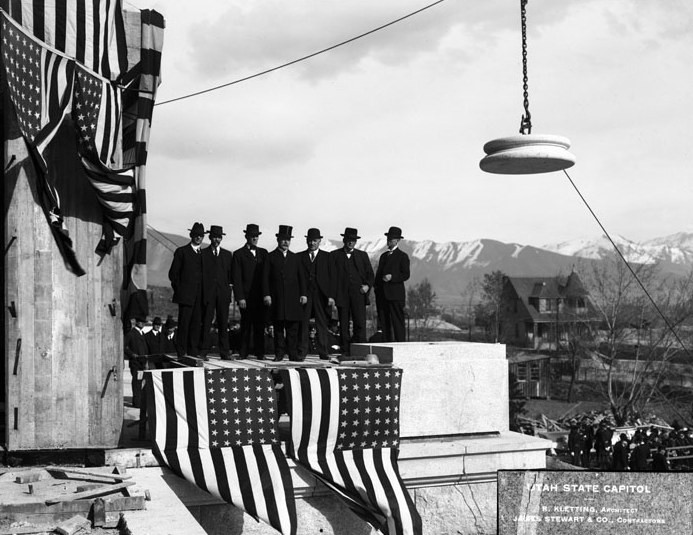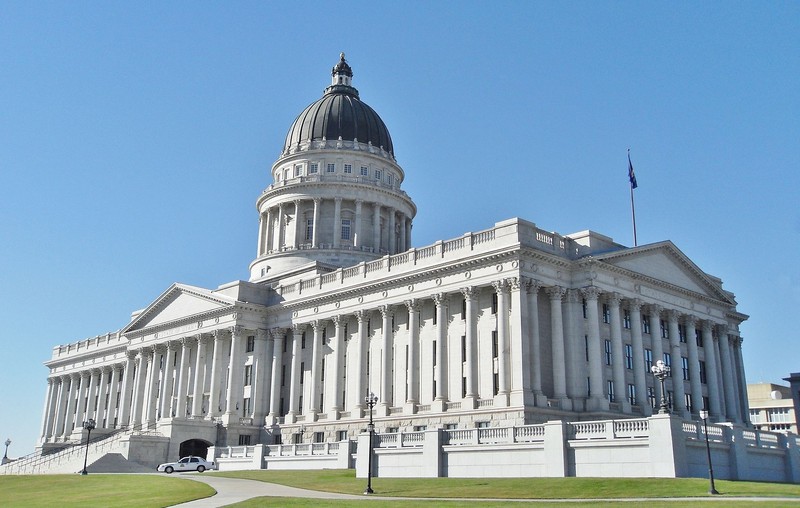Utah State Capitol
Introduction
Text-to-speech Audio
The Utah State Capitol is the house of government for the U.S. state of Utah. The building houses the chambers and offices of the Utah State Legislature, the offices of the Governor, Lieutenant Governor, Attorney General, the State Auditor and their staffs. The capitol is the main building of the Utah State Capitol Complex, which is located on Capitol Hill, overlooking downtown Salt Lake City. The capitol has been used for promotional photos for the film, Legally Blonde 2: Red, White and Blonde and had a scene filmed inside for the 1999 film, Drive Me Crazy.
Images
Original Utah Territorial House

Capitol under construction in 1914

Laying of corner stone

Utah State Capitol today

Backstory and Context
Text-to-speech Audio
The settlers arrived in what would become Utah on July 24, 1847, which is now commemorated as Pioneer Day in the state. These settlers, Mormon pioneers led by Brigham Young, appealed to the United States Congress for statehood in 1849, asking to become the State of Deseret. Their proposal was denied, but they received some recognition in September 1850 when the U.S. Government created the Territory of Utah as part of the compromise of 1850. A territorial assembly, known as the Utah Territorial Legislature, was created to be the governing body for the territory. The assembly met in various buildings including the Council House, which had originally been constructed to serve as capitol of the provisional State of Deseret, until the first capitol building was constructed.
One of the first official acts of the assembly was to designate a capital city for the territory. On October 4, 1851, Millard County and its capital of Fillmore were created in the empty Pavant Valley for this purpose. The area was named for then current president Millard Fillmore. Its centralized location in the territory made it seem an ideal place for Utah's capital city.Construction started on Utah's first capitol building, known as the Utah Territorial Statehouse, the next year. The building was designed by LDS Church Architect Truman O. Angell, and was funded with $20,000 appropriated by the United States Congress. The $20,000 was insufficient to pay for the capitol as designed, and so only the south wing was completed. In December 1855, the fifth Utah Territorial Legislature met in the building (it would be the first and only complete session in Fillmore). The next year the sixth Utah Territorial Legislature once again met in the statehouse, but the session was relocated to Salt Lake City after legislators complained about the lack of housing and adequate facilities in Fillmore. As a result in December 1856 Salt Lake City was designated Utah's capital, and the statehouse in Fillmore was abandoned. Several buildings in Salt Lake City then served as temporary homes for the state legislature and offices for state officers, including the previously used Council House, and beginning in 1866, the Salt Lake City Council Hall.
As time passed, those smaller buildings became inadequate, so several local leaders and businessmen began to call for a new permanent capitol building. Several of these people requested that Salt Lake City donate about 20 acres of land, specifically an area known as Arsenal Hill, just north of the intersection of State and Second North Streets. The City Council of Salt Lake responded by approving a resolution on March 1, 1888 donating the property to the territorial government. A "Capitol Commission" was created to review the design and construction process for the new building. The commission selected Elijah E. Myers, who also designed the Michigan, Texas, and Colorado State Capitols, to design Utah's building. The plans were finished by 1891, but were ultimately rejected because of the $1,000,000 cost estimated. Plans for a capitol building were then delayed after the approval of an Enabling Act allowing Utahans to begin plans for statehood. On January 4, 1896 Utah was granted statehood, and the Salt Lake City and County Building was used as a capitol building for the new state.
By 1909 no capitol had yet been constructed and Governor William Spry, recognizing that Utah was one of only a few states without a capitol building, sent a proposal to the state legislature asking for the creation of a new commission to oversee the construction of a capitol. During that year's legislative session the commission was created and efforts made to gain funding for construction. An appropriation bill, which would use a one mill property tax, was produced but failed in a required popular vote that June. Funding options in the form of bonds and loans were also researched. In 1910 the state constitution was amended to allow bonding for the capitol building, and by 1911 a bill authorizing $1,305,000 in bonds was presented to the state legislature. The bill passed both houses after the amount was reduced to $1 million and was signed into law by the governor in Spring 1911. Funds were also boosted when Union Pacific Railroad president, Edward Henry Harriman, died in 1909, and his widow was required to pay a five-percent inheritance tax to the state of Utah. Union Pacific had helped to construct the Transcontinental Railroad, which was completed in Utah, and Harriman had invested $3.5 million in Salt Lake City's electric trolley system. Because of these investments within the state, Mrs. Harriman paid the state treasurer $798,546 on March 1, 1911, as required by law.
After funding was secured, the commission began the design process for the building and grounds. The Olmsted Brothers of Massachusetts were chosen to provide the landscaping design and site plan. As options for the site on Capitol Hill were researched several members of various committees expressed concerns with the proposed site, due mainly to the cost of grading the steep hillside. In December 1911, a three-person committee was organized to consider other locations for a capitol building. One of the more popular sites considered was located on Fort Douglas property, near the present University of Utah, while others proposed locating the building in downtown Salt Lake City near the City and County Building. In the end, it was decided to construct on the original 20 acres site known as Capitol Hill, and attempt to acquire surrounding property for the capitol campus. Aware of the demand for their properties, several owners charged the state exorbitant prices for the property needed to complete the site.
Even as questions arose concerning the site location, and work progressed on site plans, the design of the building was begun. The commission decided to hold a design competition, a practice common for many public buildings of that era. A program for the competition was created with design requirements such as required square footage, the desired number of floors, and stipulation to keep the total cost under $2 million. The program was approved August 30, 1911, and information was sent to architectural firms. Those which were interested responded, and the commission selected twenty-four firms to compete. Because the compensation was less than expected, several contenders withdrew from the competition, and the commission further reduced the list to eight firms. The final designs for the building were due on January 12, 1912, less than five months after the finalists were selected. After designs were submitted the commission met several times to discuss their selections, and some architects were asked to make presentations. After two months the commission reduced the list of designs to just two, those submitted by Richard K.A. Kletting and Young & Sons, both of Salt Lake City. On March 13, 1912 the commission made its final vote and selected Richard Kletting's design by a vote of four to three. After his appointment as capitol architect, Kletting traveled to several capitols in the eastern United States, including the Kentucky State Capitol which influenced his final designs. His first working plans for the building were due July 15, 1912.
After Kletting produced more detailed plans, they were made available to contractors interested in bidding to work on the capitol. The submitted bids were opened December 3, 1912 at Salt Lake's Commercial Club with James Stewart & Company receiving the contract as general contractor on December 19, 1912. P. J. Morgan was awarded the contract for excavation and grading the site, and the capitol's groundbreaking ceremony took place December 26, 1912. A large amount of soil had to be excavated from the hill side, as the eastern side of the site was as high as the building's planned fourth story. The excavation was done using a steam shovel which dug into the hillside filling its large dipper, after which it turned around and emptied the dirt into a temporary Dinkey train. The small train then carried the soil to the nearby City Creek Canyon where it was dumped. After the building's base was graded and excavated, work on the foundation started. The capitol was to be built of stone, with a concrete and steel superstructure.
By spring 1913 the foundation and basements walls were in place, and the steel columnns and wooden frames for the concrete were being installed. Numerous small shops and offices had been constructed on the hill surrounding the site to support the building efforts, along with numerous small railroad lines carrying stone, mixed concrete, and other supplies. Contractors leased a right-of-way up Little Cottonwood Canyon, which originally held a railroad track from mines at Alta, and constructed a new railroad to carry granite from the canyon's quarry to the capitol site. On April 4, 1914, Governor William Spry presided over the cornerstone-laying ceremony. The cornerstone, dated 1914, was laid at the top of the southern steps, and was filled with records and photographs documenting the building's construction and Utah's culture.
By the end of summer 1914 the basement, second floor, and exterior walls were nearing completion. The columnns were being installed, and work progressed on the dome, including covering it in Utah copper. The capitol commission urged the work forward, hoping the eleventh session of the Legislature would be able to meet in the building the following year. But, as 1914 ended, work had not progressed enough and when the legislature met the next year, it did so in the Salt Lake City and County Building, until February 11, 1915, when the session was moved into the new capitol. Even though the legislature was meeting in the capitol, it took more than a year to finish the remainder of the building sufficiently for the executive and judicial officers to occupy the building. After work was finished the capitol was publicly dedicated on October 9, 1916. The original construction cost was $2,739,538.00 and replacement cost is estimated at $310,000,000.
In summer 2004 the capitol closed for an extensive renovation, which included restoration work and a seismic upgrade. The renovation was guided by three main goals, first strengthen the structure to withstand as much as a 7.3 magnitude earthquake, then restore the original architectural and artistic details of the building, all while retaining functionality after the renovation. On August 7, 2004, the day before the capitol closed, a "Capitol Discovery Day" was held, and the public was invited to visit the capitol and learn about the changes being made, and why the project was necessary. By August 8, the day the capitol closed, the renovation had already begun in certain locations around Capitol Hill. In 2002, following the 2002 Winter Olympics, some buildings added to the capitol campus, such as the circular cafeteria building, were demolished, and construction started on two new buildings. These two buildings, constructed north of the capitol, would serve as temporary offices during the structure's restoration. Much of the asbestos on the exterior of the building (used to waterproof the dome) had been removed that summer by inmates from the Utah State Prison, working in the Utah Correctional Industries program.
Some of the major improvements made during the renovation included updating or replacing the heating, cooling, plumbing, and electrical systems. Many rooms in the structure were restored to their original size, having been divided into smaller rooms over time; while others, like the Senate Chamber, were enlarged. Rooms were repainted their original colors, and new carpets, matching the 1916 originals, were installed. The 550 original windows had been replaced with aluminum trimmed ones in the early 1960s, and during the restoration they were replaced with replicated mahogany-trimmed, energy efficient, and in some areas bulletproof, windows. Original furniture was restored, and new period furniture was purchased. The floor of the rotunda had originally included glass, which allowed light to pass from the skylights down to the first floor, and the glass was restored during the renovations.
One area which received much attention was the building's dome. The dome's drum, or circular base, experienced water leakage for many years. Contrary to architect Kletting's design, the state had used stucco and plaster, versus terra cotta, to give the appearance of stone on the exterior of the dome. Over time, the plaster deteriorated and allowed water penetration that damaged the interior murals. In an effort to stop this the state had coated the drum area with a coating made of asbestos. During the restoration, the asbestos was removed, and actual terra cotta replaced the leaking plaster and stucco. In the dome's interior structure, a cathodic protection system was installed to prevent any further damage to the concrete and steel. The system uses a network of electrical anodes to induce a small electric current into the steel, altering the electrolytic cycle and slowing the corrosion process. To help increase the dome's strength, a new six-inch shot concrete wall was applied over the existing concrete inside the dome's structure.
Arguably the largest part of the renovation was improving the building's resistance to earthquake damage. A base isolation system was installed under the building to provide this protection. The building's isolation system is composed of a network of 280 base isolators, each 20 inches (51 cm) high, and between 36 inches and 44 inches in diameter. Installing the isolators required excavating the dirt around and beneath the capitol, exposing the foundation and footings. The original concrete support columnns were then attached to a network of new load transfer beams, which extended horizontally from under the building, and were supported by pile caps under and along the perimeter of the capitol. The support columnns were then detached from the original footings, leaving the building sitting on the load transfer beams and pile caps. A new concrete mat was poured around and on top of the original footings, leaving a space between the new load transfer beams and the concrete mat. The base isolators were then installed on top of the concrete mat, directly above the covered footings. Once all the isolators had been installed the temporary supports between the pile caps and load transfer beams were removed, leaving the beams to sit directly on the isolators, which sit on the concrete mat foundation. The isolators are made of layers of laminated rubber, and are very strong vertically but not horizontally, which allows the building to rock gently back and forth as the ground underneath moves during an earthquake.
Several other improvements during the renovation will help to improve the building's stability, including the addition of concrete shear walls within the structure. The shear walls will keep the building from twisting or distorting, which could cause a collapse as it moves during an earthquake. The shear walls were installed in empty vent shafts left from the original construction, and inside new elevator shafts and stairwells. The granite columnns along the structure's exterior were also in danger of buckling during a seismic event, and as a result the joints were injected with an epoxy adhesive during the renovation work.
The innovative restoration and upgrade was the first of its kind on such a large scale. The final cost was $260,000,000 which did not include the construction of two additional legislative office buildings on the capitol campus at a cost of $37,000,000 each. The capitol was rededicated on January 4, 2008, and opened to the public the next day. Funds dedicated to the capitol complex make it the costliest state capitol complex in the United States.
Sources
Lyman, Edward Leo (1994), "Statehood for Utah", in Powell, Allan Kent, Utah History Encyclopedia, Salt Lake City, Utah: University of Utah Press, Cooper/Rogers Architects (13 September 2000). "II". Building & Grounds Restoration Master Plan and Historic Structures Report (PDF). Capitol Preservation Board. Ison, Yvette D. (July 1995). "Utah's First Territorial Capitol, Fillmore, Was Too Remote for Legislators". History Blazer. Utah History To Go. . Cooley, Everett L. (July 1959). "Utah's Capitols" (PDF). Utah Historical Quarterly 27 (3) (Utah Historical Society). p. 263. "Utah Capitol resembling Parthenon, will be built by Utah Architect". The Salt Lake Evening Telegram (Utah Digital Newspapers). 14 March 1912. "Capitol Cornerstone will be laid today". The Salt Lake Evening Telegram (Utah Digital Newspapers). 4 April 1914. Warburton, Nicole (3 January 2008). "Capitol redux: Historic building's renovation complete". Deseret News. Erickson, Tiffany (10 August 2004). "Thousands bid Capitol farewell before 4-year renovation starts". Deseret News. Nielson-Stowell, Amelia (1 August 2004). "Designs more inviting to public". Deseret News. Genessy, Jody (10 August 2004). "'Chain gang' working at the Capitol". Deseret News. Utah Division of State History. "The Utah State Capitol: Then and Now". Utah State History website. Johnson, Jerod G. (2005). "Modern Solutions to Historic Problems: The Utah State Capitol Building Seismic Retrofit Project" (PDF). Utah Preservation 9 (Utah State Historical Society). pp. 52–56. "Utah State Capitol Seismic Retrofit and Restoration" (PDF). Parsons Corporation. December 2006. Architect of the Capitol. "The United States Capitol Dome". Architect of the Capitol website. Gehrke, Robert (25 January 2010). "Lobbyists set up in new Capitol quarters". The Salt Lake Tribune (Salt Lake City). Cooper/Rogers Architects (13 September 2000). "III". Building & Grounds Restoration Master Plan and Historic Structures Report (PDF). Capitol Preservation Board. State of Utah (2008). "Virtual Tour". Utah State Capitol website. "J. R. Clancy and Oasis Stage Werks Provide Rigging Solution For Utah State Capitol Chandelier". Lightandsoundamerica.com. 9 July 2008. Utah House of Representatives. "About - Utah House of Representatives". House of Representatives website. Whitney, Susan (1 August 2004). "Fixer-upper: State Capitol building is closing for 4-year, $200 million renovation". Deseret News.
